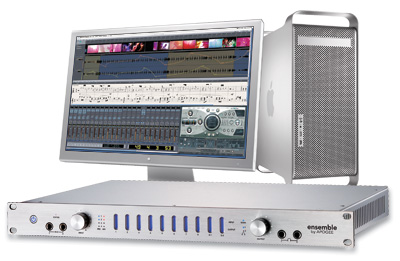NAMM: Apogee Electronics are known for providing some of the best analog-to-digital (and back) conversion in the business, period. It’s this critical step in working with digital sound that draws the attention of many golden-eared producers and engineers. Apogee does digital audio very, very well. But many people think of their hardware as a front end to a Pro Tools HD setup (or other digital system).
Now imagine for a second that, instead, you walk into a studio and see Logic Pro running with all Apogee hardware on a Mac. I think that might get your attention even if you never need 192 simultaneous audio channels. And it’s all because of a new hardware-software combination, pictured. Here’s the latest:

Apogee has introduced two products especially for the Mac: the 36-channel Ensemble audio interface, and 96-channel PCI Express Symphony card. They’re both designed for the Mac, and Ensemble is built with special Core Audio features and Logic Pro integration.
Now, if you’re the kind of person who’s considering buying three Symphony cards for 192 channels of I/O, please stop listening to me right now. I’m almost positive I’m one of the last people who could possibly give you advice, as I sit here in my hotel room monitoring a new piece of music through my PowerBook’s headphone out jack, okay?
I can say, though, this is a big step for Logic, the Mac, and Apogee. The integration sounds terrific: the software features exclusive Logic Pro integration for “multiple low latency mixers, an input and output routing matrix, and a universal control platform for using Ensemble in combination with other Apogee hardware.” That hasn’t been possible with any other system I’ve seen — and it would appear to be thanks to Logic’s unique architecture and the multichannel capabilities of Core Audio in Mac OS X.
It’s also a major shot across the bow of Pro Tools, which has maintained its hegemony in large part due to the combination of Pro Tools hardware and software. (Even, ironically, if many studios bypass the A/D and D/A converters on their very expensive Digidesign hardware to use devices like Apogee’s.) Logic Pro has made a lot of headway in the last couple of years, as have Nuendo, Cubase, SONAR, Digital Performer, and even software like Ableton Live. But there’s clearly a need for turn-key, high-end hardware solutions. (As a reader thoughtfully points out, I should note that thanks to the collaboration between Yamaha and Steinberg, Nuendo is also able to offer real hardware/software integration. And accordingly, Nuendo is also starting to make real inroads into studio use, often at significantly lower cost and with unique capabilities compared to Pro Tools setups. So I think it’s clear that hardware/software integration is an important component of broadening this market.)

I’ll be sure to put Apogee on my list here at NAMM to see what their take is, and look forward to hearing Apple’s impressions of this deal now and over the coming months. I’ll keep you posted.
In the meantime, if this is something of use to you, go check out the products and let me know what you think! (After all, part of why I enjoy running this site is I get to hear from people who actually are qualified to speak about topics which I’m not! Viva collective intelligence!)
Apogee Electronics Symphony PCI-Express Card
Apogee Electronics Ensemble, Featuring Logic Pro Integration
Oh, and PC users, I promise some Windows love this week. Wait until after I’ve gone to the big Microsoft-Intel party. In fact, they’ll probably be happiest if I write while I’m drinking their complimentary cocktails. (Especially if they laced it with some reality distortion PC love potion. Except I have to meet with Apple first . . . well, see how it turns out.)